The thinnest heel. Heeled shoes: style, femininity, charm.
Shoes with heels visually make your figure slimmer, help straighten your back and tighten your stomach, give you self-confidence and turn an ordinary gait into a sexy one. But only if you know how to choose and wear such shoes correctly.
Since the 18th century, women's high-heeled shoes have become part of women's clothing. Since then, the heel began to dictate shoe fashion. From time to time its shape and profile changed. So in the 17th century. They wore curved “French” heels in the 18th century. - column-shaped, later “pumps” with thin heels with a curved heel came into fashion, then low shoes with heels - moliere. In 1938, beach sandals made of wood with thick soles and column-shaped heels appeared. In the 40s Wedges became popular - shoes with thick soles, gradually turning into high heels. In the 70s a high thick heel and a thick sole appeared - a platform. Very thin and high heels"hairpins".
Viennese heel. A small (1.5-2 cm) heel that increases the longitudinal arch of the foot. One of the most comfortable and beneficial for the foot.
Brick heel. A small (2-4 cm) stable heel, shaped like a square. Perfect suitable for girls from 180 cm and above.

Wedge heel. Wide and high heel. Its back is much longer than its front. This form suits absolutely everyone. Because the contrast of the leg with such a heel makes it look slimmer.
Cowboy. Heel with a bevel at the back. Looks tilted, but very comfortable. Shoes with such a heel look slightly rough, making your feet look more elegant in them.

Taper at the base and a strongly tapered heel. Height can vary from 5 to 12 cm.
A glass. Wide at the base and narrowed at the bottom, like the stem of a glass. This heel is not too high (no more than 7 cm), but also not very stable.

Column. A fairly wide straight heel (from 5 cm and above). It is very stable, so it gives confidence to your gait.
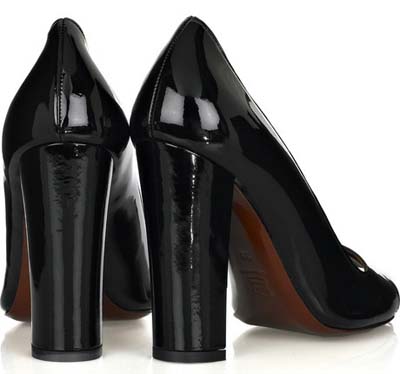
Wedge heel. Chopines (stumps), or walking footstools. Japanese geta, Greek buskins, Venetian zoccolo - perhaps the most ancient look heel Shoes with solid soles made of wood or cork, sometimes without instep, from 4 to 30 cm (or more). Very stable, but inconvenient for driving a car.

Stiletto heels. A high (8-12 cm) thin heel, which is based on a metal rod (a model where the rod is not covered with anything is called a stiletto). The sexiest heel option.

HOW TO CHOOSE?
1. Keep in mind that every two centimeters of heel height increases the pressure on your toes by 25%
2. First try on shoes while sitting, and then stand up and walk around. Because when you sit, the length of your foot decreases by 0.5-1 cm.
3. If you buy shoes without a heel, but with a heel, choose models with straps or ties and a tight-fitting front part, otherwise your foot may roll.
4. Place the model you like on a flat surface (without putting it on); if the toe lifts up too much, the shoes will be uncomfortable to wear.
5. For every day, choose shoes with heels up to 6 cm.
6. Check how the heel is attached; if you can move it a little with your hand or loosen it, then you should not buy such a model - its heel or instep support may break.
7. The heel should be nailed, not glued, and the instep should be made of metal.
8. The difference between the height of the heel and the height of the supporting part should be at least 0.5 cm.
BEWARE:
Constantly wearing high-heeled shoes (above 5.5 cm) is harmful. This impairs blood circulation and deforms the calf muscles. The optimal heel height is 1/4 of the length of the foot. It’s better to organize a catwalk show in stiletto heels 2-3 times a week.
Shoes without any heels are also unsafe: they do not have an instep support, and this makes the ligaments that support the arch of the foot very tired.
It is easy to twist your foot in platform shoes, so they are not suitable for long walks and uneven roads.
Any heel will be uncomfortable if you walk incorrectly. Learn to distribute your body weight evenly across your feet. To do this, you need to keep your back straight, but not tense, and be sure to straighten your knees when walking. Try not to put pressure on your heels, but don't try to walk on your toes, otherwise your feet will quickly get tired and hurt. It is better to choose lower heels, but walk beautifully
Heeled shoes, originally invented by men and for men, are today the inviolable property of women. It is thanks to the heel - this important element of the shoe - that fashionistas can look more feminine and even slimmer. Each of us has shoes, ankle boots, boots, and other models of similar shoes in our wardrobe. Obviously, these heels differ not only in height, but also in shape. What types of heels are used to create female models shoes? To summarize, there are only ten types of heels on modern shoes, but each can have several subtypes.
So, modern experts distinguish the following types of heels:
- Viennese;
- bricks;
- wedge-shaped;
- cone-shaped;
- cowboy;
- glasses;
- columns;
- wedge;
- hairpins;
- typesetting.
Let's take a closer look at each of them.
Types of women's heels
The lowest of all is Viennese heel. The versatility of this model is that the shoes can be both casual and for going out. In addition, this is the most “correct” option in terms of the health of our legs.
If the Viennese heel is increased in height to two to four centimeters, then it will turn into brick heel. These shoe models are practical.
If a low, square-shaped heel has a bevel at the back, it is called cowboy.
Wedge heels They are a prism turned upside down. The specified shape of the heels visually slims the legs and fits perfectly with anyone.
A cone heels most often have a height exceeding eight centimeters.
Shoes with such heels are stable and incredibly comfortable, which cannot be said about shoe models with glass heels. If its height is less than six to seven centimeters, then you can still walk, but if it’s more, it’s even dangerous!
Salvatore Ferragamo
Simply put, a Viennese heel is just a thick heel on your sole. It’s hard to call it a heel, but still. Almost every type of flat-soled shoe has a similar imperceptible “rise”, which most often amounts to some 0.5-2 centimeters maximum. Most often, the Viennese heel can be found on ballet flats or sandals, but it is also widespread among other types of shoes - loafers, derbies, ankle boots.
Brick heel
 Saint Laurent
Saint Laurent
Shoe models with such heels are durable and practical. The brick heel, as you might guess, is square-rectangular in shape, slightly rounded at the heel. The heel rise ranges from 2-4 centimeters. Most often, this heel, like the Viennese heel in general, can be found on men's shoes, however, it is also very popular among women (think Oxfords or Chelsea)
Wedge heel
 Gucci
Gucci
This heel is definitely hard to confuse with anything else! The main feature here is its recognizable shape, and not its height, which, by the way, can be absolutely anything. The very word “wedge-shaped” in the name hints at the fact that the heel is similar to a wedge, that is, a figure tapering downwards. To put it more simply, you should imagine an inverted triangular prism and, voila, a wedge-shaped heel is right there. Another interesting thing is that this particular type of heel is considered the most universal - it fits many shoe models and tends to be combined with almost any clothing (dresses, trousers, shorts, skirts - whatever). Plus, it visually slims the leg and elongates the silhouette.
Cowboy heel
 Isabel Marant
Isabel Marant
Fans of Westerns will definitely enjoy this part of the article. The cowboy heel is a low, square-shaped heel with a tapered back. Mostly found on cowboy boots or oxfords, which have been especially popular over the past few seasons. Such boots, and therefore heels, go perfectly with jeans absolutely different types(feel free to choose not only skinnies, but also flares), as well as with flowing dresses, cardigans, long vests and in general everything Texas cowboy style.
Glass heel
 Dolce & Gabbana
Dolce & Gabbana
This is another representative of the associative heel. A glass heel, which usually does not exceed 5 cm, resembles in shape, as you might guess, the leg of a glass, which has a wide, stable base at the top and subtly tapers towards the bottom. Most often, to be honest, this type of heel is condemned because of its inconvenience (unstable), but many vote “for” and defend it in every possible way. A glass heel is a kind of acceptable middle ground between shoes without heels with flat soles and between, say, stiletto heels. You can safely choose this heel if you want to look elegant, but at the same time you know that you will spend the whole day on your feet. It also goes great with any outfit. And don’t forget that dancers wear similar heels Latin American dances- a subtle hint that these heels will be very appropriate on the dance floor.
If it occurs to you to look for shoes with a glass heel in English-language online stores, then you need to enter “kitten-heels” in the search bar. This English name The small glass heel entered the fashion world thanks to Audrey Hepburn. It was she who popularized teenage shoes with training heels - a miniature version of the stiletto - making them a fashionable element of the adult women's wardrobe of the 50s.
Column heel
 Aquazzura
Aquazzura
From 5 cm and above - just like that, we gradually moved from geometric “bricks” and “cones” to everyone’s favorite high heels, which certainly don’t “just happen.” The column heel is perhaps the most common type of high heels, and also the most stable (even at 12-15 cm you will feel comfortable). The heel fits tightly directly to the sole, does not narrow or deform anywhere, but on the contrary, lives up to its name - like a pillar stands firmly on the ground. Shoes with such heels are comfortable for everyday wear, acceptable both in the office at work and at a party.
Hairpin
 Christian Louboutin
Christian Louboutin
Well, what would we do without elegant, leg-lengthening stilettos? A girl is not a girl if she doesn’t have one pair of black classic pumps with thin, elegant stiletto heels lying in her closet, at least on the farthest shelf. You shouldn’t think that a hairpin resembles in shape something similar to a needle or a nail (although this also happens); most often it’s quite the opposite; a hairpin is actually much more stable and “thick” (1-2 cm thick). You can easily find it on any model of shoes, sandals or ankle boots. Properly selected stiletto heels, the height of which, by the way, is 7 cm or more, are an indispensable attribute of an evening look. Interestingly, the basis of the hairpin is the so-called stiletto; if the heel is not covered with anything, then it is called not a stiletto heel, but a stiletto (usually where thinner than a stiletto heel, exactly the same “needle” shape that we talked about above).
Wedge or platform
 Castañer
Castañer
Only a few manage to avoid the fate of buying an original pair of wedge shoes, especially in the summer months. Shoes with such heels are very comfortable and stable, which is why they are so common in spring-summer collections. In general, a wedge heel is a solid sole with a rise (the same “platform”), which can be of different heights (from about 5 to 18-20 cm).
Stacked heel
 Michael Kors
Michael Kors
A stacked (or layered) heel consists of special layers called fleeks. Flick is an intermediate piece made of leather or cardboard, the thickness of which corresponds to the stacked heel. Most often, shoes with such heels do not exceed 10 cm in height. Sometimes there are layers of flicks in stacked heels are painted in different colors to give the shoes originality.
Curly heel
 Sophia Webster
Sophia Webster
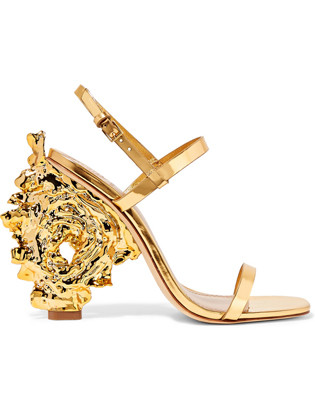 Tory Burch
Tory Burch
And finally, the last type of heel on our list is the one that you won’t see on the street at all! Curly heels are all those same incredible and unimaginable models of shoes with fanciful, even crazy platforms and stiletto heels. “Creative heels,” as they are often called, most often walk on the ready-to-wear and couture catwalks during fashion weeks in Paris, London or, say, New York. I had a special love for curly heels Alexander McQueen– remember those incredible closed-toe shoes studded with rhinestones and diamonds from Lady Gaga for the Poker Face video. Or, say, take Christian Dior shoes with a curved heel.
This important component of any shoe was invented in the 12th century by horsemen. It was attached to the shoe so that the foot was well positioned in the stirrup. More modern look heels were designed by Leonardo da Vinci, and wearing them came into fashion only in the 17th century.
Heels began to be used to appear taller, and some ladies preferred to wear heels higher than fifteen centimeters. It was extremely difficult to move at such a height, so they were helped by servants supporting them on both sides. There are 10 types of heels differing from each other in size and shape.
Vienna heel
The lowest is from one and a half to two centimeters. Typically, such a heel can be seen in ballet shoes, sandals, and flip-flops. These shoes are perfect for any girl's everyday look. Depending on the type of shoe, Viennese heels will look good with trousers, jeans, and dresses.
Brick-shaped heel
Height - from two to four centimeters. Most often it can be found in men's shoe models - boots or shoes, for example, Oxfords. Due to its shape it is very practical and stable to wear.
Wedge heel
This heel has no height restrictions; it stands out due to its shape – a triangular prism. For example, pumps or sandal boots with open parts. It will suit any look, and in addition, it creates the appearance of slender, long legs.
Cowboy heel
A heel whose back is slightly angled, making it undeniably comfortable. It is not difficult to understand by the name; it can most often be found in the corresponding “cowboy” boots, which are Lately are not very popular among fashionistas. But a slightly “boyish” look will add some zest to your look and will look quite feminine on your feet.
Cone shaped
From the name it is easy to guess that the shape of such a heel resembles a cone, i.e. it gradually narrows downwards. Most often this is a high heel, about six to twelve centimeters.
glass
Usually a low heel - up to about seven centimeters. The shape is very similar to the stem of a glass - very wide at the base and very narrow at the bottom. Such heels are extremely unstable and can look awkward on some sandals or boots. But, for example, it looks quite elegant and appropriate on dancers.
Column shaped
High heel - most often its length starts from five centimeters and above. It is uniform, wide and straight. Quite comfortable and stable when walking. It happens, just like with shoes, so with boots.
Wedge heel
This is a sole with a height of five to thirty centimeters, sometimes with an additional rise or platform. These shoes are considered quite comfortable to wear except while driving a car.
Hairpin
A type of heel that, as they say, is “always on everyone’s lips” and was invented quite recently - in the mid-twentieth century. Its height is usually eight centimeters and above. This is a thin and not always very stable heel. A hairpin is a stiletto covered with material, which is its core. Stiletto heels look very elegant and festive.
"Typesetting"
From the name it immediately becomes clear that such a heel is “assembled” from several “flicks”, which are most often made of leather or thick cardboard. The size and shape of such a heel can be any. It is quite comfortable to wear and, unlike wedge shoes, is ideal for driving a car.
Nothing adorns a woman more than high-heeled shoes. The gait immediately becomes sexy, the posture becomes royal, and the overall image becomes feminine and elegant.
The heel does not have to be high - even a small heel can transform the appearance and give self-confidence to fashionistas of different heights and ages, this can be seen in any photo.
The heel can be high or low, wide or thin, but in fact there are several more varieties of this shoe part. Let's look at the main types of heels that are found today on the streets, store shelves and fashion catwalks.
This is the smallest heel, its height is no more than 2 cm. The heel is quite wide and incredibly comfortable. Tall girls love these shoes, as well as those who suffer from pain in muscles and joints due to prolonged standing on their feet.
The Viennese heel can decorate shoes, sandals, sandals, ankle boots, boots - it is truly universal. These shoes look appropriate with both a skirt and trousers.
Brick heel
It is too wide heel, but a little higher - up to 4 cm. Such shoes are considered even safer than shoes without heels or with Viennese heels. Therefore, brick heels are chosen for winter boots and shoes.
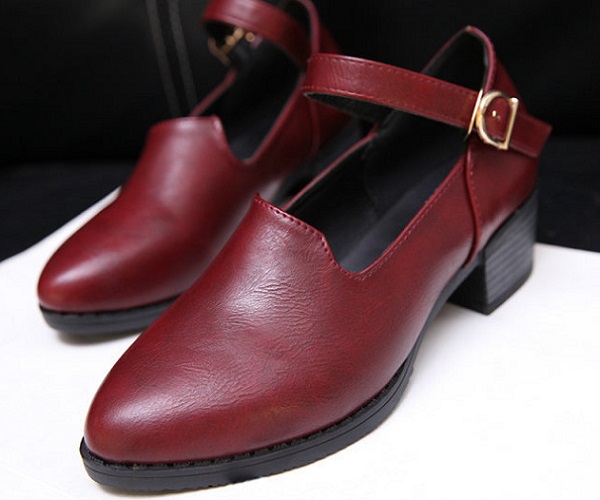
If a brick heel adorns lace-up shoes, then it is better to wear them with trousers, and high stocking boots with such a stable heel are quite suitable for a skirt or dress.
Wedge heel
The peculiarity of such a heel is that its height is not the same. The back wall of the heel is noticeably higher than the wall located closer to the middle of the foot.

The shape of the heel resembles an inverted pyramid - it widens at the top and narrows at the bottom. This heel is quite stable and visually slims the figure; it is most often used in ankle boots and sandals.
Cowboy heel
This is the heel of the so-called cowboy boots; it resembles an inverted truncated pyramid. Its back wall is slightly beveled inward, which looks quite elegant.

Shoes with such heels often have a raised toe, this makes the models more graceful and stable. Shoes and sandals can also be worn with cowboy heels.
Cone heel
A cone heel is a high heel that looks like an inverted elongated cone with a truncated top. If you love high heels, choose a tapered heel for a comfortable heel that looks elegant.

Cone heels can be seen on shoes and sandals, ankle boots and boots; this heel is in perfect harmony with skirts and skinny trousers.
Glass heel
The name speaks for itself - this heel looks like a glass on a leg, it is narrow at the bottom and wide at the top. This is always a low heel - a maximum of 7 cm, found in shoes, clogs, ankle boots, and most often in sandals.
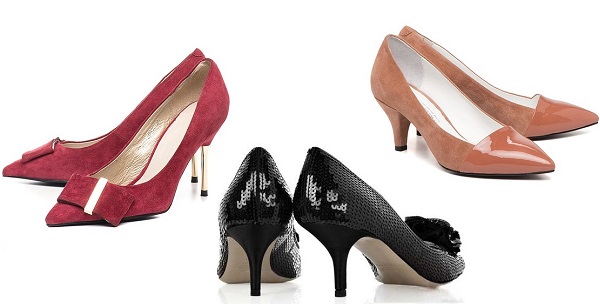
The glass heel is considered not very comfortable, but it is preferred by many fashionistas tall who cannot afford stiletto heels.
Stiletto heel
It's tall enough thin heel. The stiletto heel is recognized as the most feminine, elegant and sexy version of the heel; classic stiletto pumps are a must-have for the modern fashionista.

A type of stiletto heel can be called a stiletto heel. This is a metal rod that is usually found inside a stiletto heel. Now it is used as a full heel.
Column heel
A very comfortable heel, despite its height - at least 5 cm. It is a fairly wide and stable heel, but narrower than a brick heel.

Column heels are found in both shoes and boots - this is the best option for those who value comfort, but are embarrassed by their short stature.
Wedge heel
This is also a type of heel and can have different heights - from barely noticeable to very high. A wedge is a heel that smoothly flows into a sole or platform.
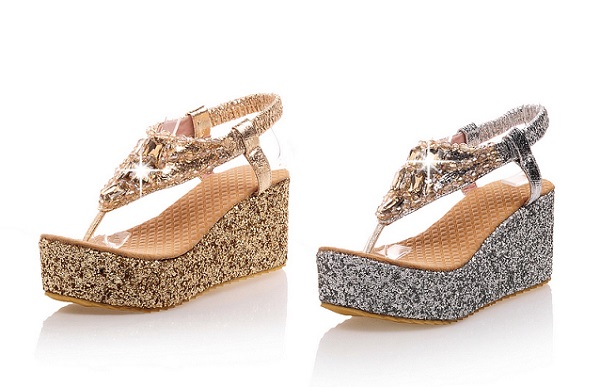
If you compare the sensations in stiletto heels and wedges of the same height, the wedge heel will be many times more comfortable, walking in such shoes is much safer, while the wedge heel copes with the aesthetic function perfectly - it lengthens the legs and gives the image a touch of femininity.
Flared heel
This is a heel that is narrow at the top and widens at the bottom. Many women consider such a heel to be rude, but designers are actively modeling more and more new versions of shoes with such heels.

Curly heel
There are extravagant shoes with heels that are difficult to classify into any of the listed categories. You can group them into one section - curly heels.

This could be a platform with a hole inside, a heel that is attached not to the heel, but to the middle of the sole, and other equally original options.
Heels will never leave women's wardrobe, on the contrary, this detail is improved from season to season, demonstrating updated modifications.
All about women's heels
In contact with

